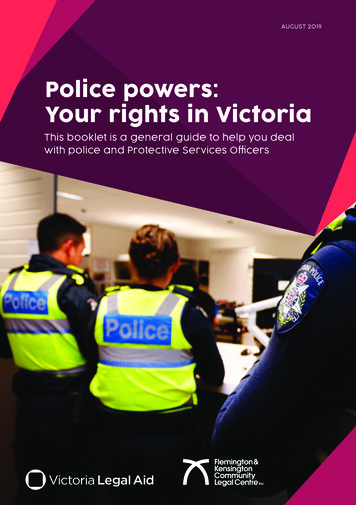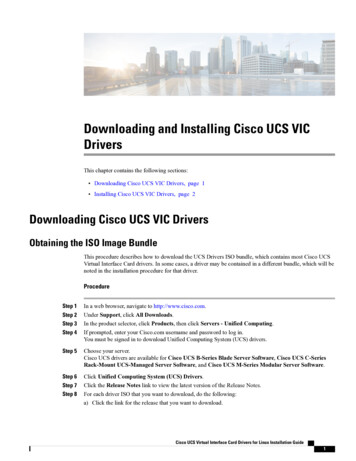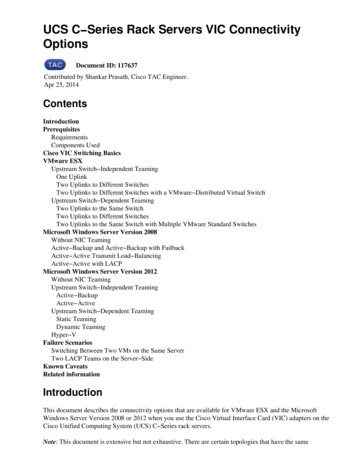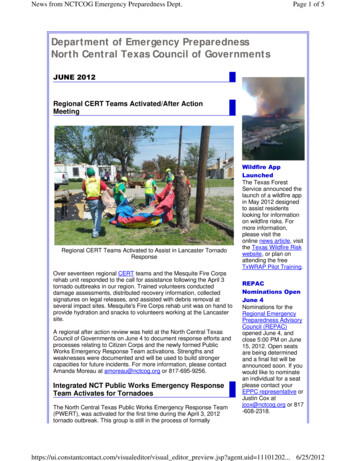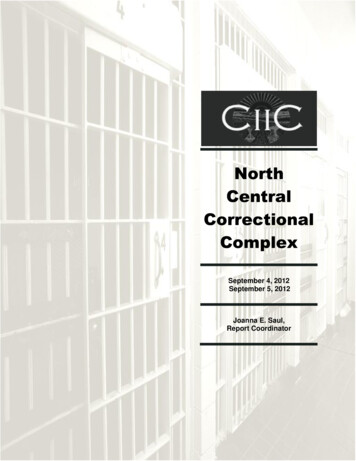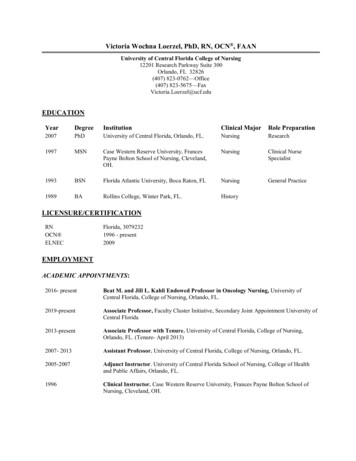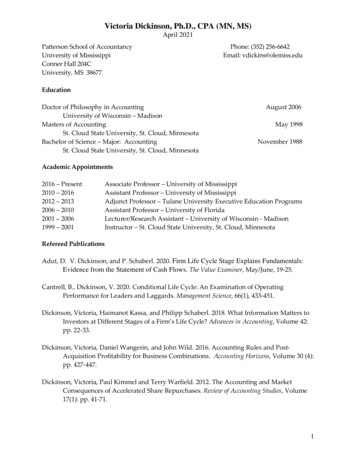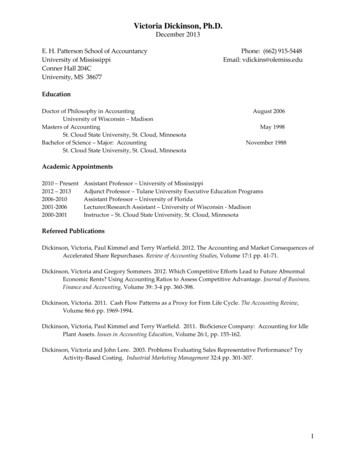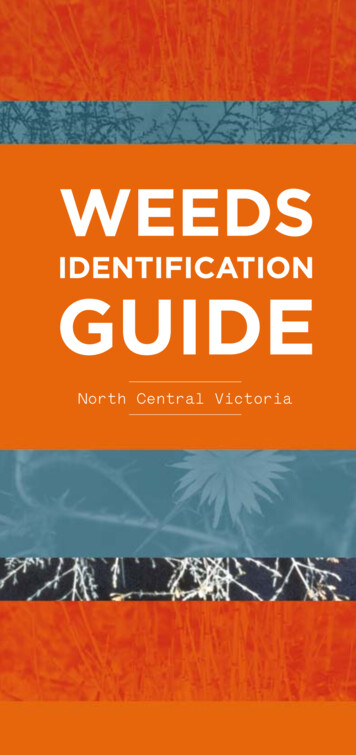
Transcription
North Central Victoria
Acknowledgement of CountryThe North Central Catchment Management Authorityacknowledges Aboriginal Traditional Owners withinthe catchment area, their rich culture and theirspiritual connection to Country. We also recogniseand acknowledge the contribution and interests ofAboriginal people and organisations in themanagement of land and natural resources.AcknowledgementsThe North Central Catchment Management Authoritywishes to acknowledge Ashley Beven, Regional LandcareFacilitator, for her effort in the compilation of this field guide.The North Central Catchment Management Authority wishesto acknowledge John Baker (Department of Sustainability,Environment, Water, Population and Communities),John Clayton (New Zealand National Institute of Waterand Atmospheric Research), International EnvironmentalWeed Foundation (www.iewf.org), Mark Imhof (VictorianDepartment of Primary Industries), Michael Moerkerk(Victorian Department of Primary Industries), Plants andOperations Branch (Victorian Department of PrimaryIndustries), R.G. and F.J. Richardson (www.weedinfo.com.au),Roberta Gibson (Growing with Science Blog), andSheldon Navie (Technigro) for the use of their photographs.The North Central Catchment Management Authoritywishes to acknowledge the Victorian Department ofPrimary Industries for their support in reviewing the guide.The production of this publication was made possiblethrough funding from the Australian Government’sRegional Landcare Facilitator project, which is hosted bythe North Central Catchment Management Authority,and the Victorian Government’s Landcare Program.Disclaimer This publication may be of assistance to you but the North CentralCatchment Management Authority and its employees do not guarantee that thepublication is without flaw of any kind or is wholly appropriate to your particularpurposes and therefore disclaims all liability for any error, loss or other consequencewhich may arise from you relying on any information in this publication.2nd Edition, 2012 ISBN 978-0-9871960-4-0 North Central Catchment Management Authority, 2012
ContentsIntroduction2Contact us3How to use this field guide4Legislative requirements7Environmental weeds9How to collect and preserveweed specimens10Weed descriptions12Index100References and further information1051
IntroductionWeeds cost the community millions ofdollars each year in lost productivity andhave a significant impact on the naturalenvironment.In Victoria, there are over one hundred declared noxiousweeds proclaimed under the Catchment and LandProtection Act 1994. These weeds are classified underfour categories: State Prohibited, Regionally Prohibited,Regionally Controlled and Restricted. The responsibilityfor management of declared noxious weeds varies foreach category.In addition to declared noxious weeds, there arenumerous other weed species that impact on theagricultural and environmental values of north centralVictoria. The North Central Catchment ManagementAuthority (CMA) in partnership with the Departmentof Primary Industries (DPI) coordinate a range of weedmanagement programs across the catchment in an effortto minimise weed impacts.All land managers have a responsibility to manage weedson their land, irrespective of whether the land is publicor private land. As a land manager, it is important to beable to identify weeds that may pose a threat to yourland or neighbouring land. Early identification will enableyou to implement management plans that prevent weedestablishment or spread.The purpose of the Weeds Identification Guide – for northcentral Victoria is to provide all land managers, public andprivate, with a locally relevant field guide that will assist inthe identification and management of environmental andagricultural weeds in the North Central CMA region.2
North Central CMA regionFor additional copies of this field guide or for furtherinformation please contact:North Central CMA628-634 Midland Highway (PO Box 18)HUNTLY, VIC 3551T: (03) 5448 7124F: (03) 5448 7148E: info@nccma.vic.gov.auW: www.nccma.vic.gov.auSwan HillRiver MurrayKerangcohunaquambatookpyramid hillEchucaAvoca RiverrochesterLoddon RiverDonaldelmoreRichardsonRiverbridgewaterSt ArnaudCampaspe RiverMarnooAvon tondaylesford3
How to use this guidePlant typeWeeds have been listed in the field guide based on planttype, with pages colour coded to correspond with eachplant type. Plant types include:HerbBulbGrassShrubTreeWater weedCalendar for weed controlThe shaded months in this calendar are a guide to indicatethe optimum treatment time for each weed in an averageyear. Treatment times may vary slightly due to topographyand local seasonal conditions.JFMAMJJASONDThe chart above indicates that the optimal treatmenttimes are May, June, July, August and September. Marginaltreatment times are April and October.Plant lifespanPerennialIndicates perennial weeds, which are plants that grow formore than two seasons.AnnualIndicates annual weeds, that is, plants with a growing cyclelasting one year.4
How weeds spreadWeeds may spread by many or all of the ways representedbelow. For the purpose of this field guide, only the mostsignificant methods of spread have been indicated foreach weed.Seed or plant pieces spread in farm producesuch as grain and fodderMovement of seed or plant pieces incontaminatedsoil Seed eaten or carried by birds and animalsSeed or plant pieces carried in waterSeed blown by windSeed eaten or carried by livestockSeed or plant pieces carried on machinery,equipment, boats and/or vehiclesSeed spread by slashing or mowingSeed or plant pieces spread by cultivation5
Weed control optionsWeeds may be controlled by many or all of the waysrepresented below. For the purposes of this booklet,only the most common methods of control have beenindicated for each weed.Spot spray foliage with appropriate herbicide*Cut and paint with appropriate herbicide*Mechanical removalHand weedingCultivation prior to floweringHerbicide stem injectionDPI responsible for weed control*There are restrictions on the use of some chemicals within the NorthCentral CMA region. When using herbicides consult an agronomist or ruralmerchandise store for advice on the appropriate herbicide for your situationand use in accordance with the manufacturer’s label.6
Legislative requirementsUnder the Catchment and LandProtection (CaLP) Act 1994 certain plantsare declared as noxious weeds in Victoriaand are classified as State Prohibited,Regionally Prohibited, RegionallyControlled or Restricted.State Prohibited WeedsState Prohibited Weeds either do not occur in Victoria,or it is reasonably expected that they can be eradicatedfrom the state. Department of Primary Industries (DPI) isresponsible for the management of these species whereever they occur throughout Victoria, whether it is onpublic or private land. Reporting these species to DPI willensure that treatment and removal are carried out in asafe and timely manner. If you suspect a State ProhibitedWeed is on your property please contact DPI immediatelyon 136 186.Regionally Prohibited WeedsRegionally Prohibited Weeds are not widely distributedacross the North Central CMA region but are capable ofspreading further. It is reasonable to expect that theseweeds can be eradicated from north central Victoria.Control is the responsibility of both public and privateland managers on their land and VIC Roads on DeclaredRoads under the Victorian Transport Act 1983.Regionally Controlled WeedsRegionally Controlled Weeds exist in the North CentralCMA region and are usually widespread. Continuedcontrol measures are required to prevent further spreadto clean land. Control is the responsibility of both publicand private land managers on their land and VIC Roadson Declared Roads under the Victorian Transport Act 1983.Restricted WeedsRestricted Weeds seriously threaten primary production,Crown Land, the environment or community healthin another State or Territory and have the potentialto spread into and within Victoria. If sold or tradedin Victoria there would be an unacceptable risk ofit spreading within Victoria and to other states and7
territories. There is no requirement for land managersto control restricted weeds on their property. However,they cannot be traded or transported within Victoria.Undeclared WeedsThese weeds are not classified under the Catchmentand Land Protection Act 1994, but are recognisedas a serious threat to agriculture and the environment.Weeds of National SignificanceAs part of the National Weeds Strategy, 32 Weeds ofNational Significance (WONS) have been identified, whichrequire coordinated action across all states and territoriesto reduce their impact on Australia’s productive capacityand natural ecosystems. The weeds are determinedaccording to their: invasiveness, impact, potential tospread and socioeconomic and environmental values.Control is the responsibility of land managers as per theVictorian categories of noxious weeds described above,that is: State Prohibited, Regionally Prohibited, RegionallyControlled and Restricted Weeds.8
Environmental weedsThis field guide largely addresses weeds which aredeclared under the Catchment and Land ProtectionAct 1994 and those that currently have a widespreadimpact on agricultural and environmental values in theregion. There are many weed species that have notbeen included but should be recognised as having apotential to cause serious environmental problems inthe future. Some of these weeds have been listed inthe north central Invasive Plants and Animals Strategy2010-15 as the highest risk undeclared invasive plants innorth central Victoria. Many local governments also havestrategies for environmental weeds of significance whichhighlight priorities for local action.What are environmental weeds?Environmental weeds are plant species thatpredominantly invade natural areas and competewith or choke out native plant communities.Why are they a problem?Environmental weeds cause damage to native plantcommunities by competing with naturally occurringvegetation for moisture, nutrients and light. Nativeanimal populations can also be affected by the changein vegetation due to replacement of their natural foodsource and habitat with exotic species. Weed species alsotend to provide greater harbour for pest animal speciesand some can be poisonous to stock and other animals.Where have they come from?Some environmental weeds may have been introducedaccidentally, for example, as a contaminant of importedgrain or fodder, however most have been introduced as agarden or decorative plant and then have ‘escaped’ intothe environment. The most common methods of spreadare from dumped garden waste containing bulbs, seed orroot pieces, deliberate planting in inappropriate areas andfrom birds or animals spreading seed.Common Environmental WeedsSome common environmental weeds that are notincluded in this field guide include:Arum Lily, Zantedeschia aethiopiaCootamundra Wattle, Acacia baileyanaGazania, Gazania linearisOlive, Olea europeaePampas Grass, Cordateria selloana9
How to collect andpreserve weed specimensIf you can’t identify a weed using thisfield guide, you may need to submitspecimens for identification to your localagronomist, rural merchandise store,government department or botanicalgardens herbarium.Collecting and preserving specimensGuidelines for collecting and preserving weed specimensinclude:1. I f possible, take a photograph of the weed beforecollection.2. Choose a healthy specimen and keep it in a cool, darkplace until it is pressed.3. C ollect as many plant parts as possible, including: partsof the root system and leaves in position with flowersand/or fruit.4. Ensure the specimen is clean of dirt and insects.5. Preserve the plant as soon as possible by:– Label the specimen with field and location notes– Place the specimen between sheets of newspaper– Press the specimen between flat boards of masonite,plywood or similar– Weight the specimen with bricks, books, strapsor ties.6. C hange the paper every couple of days for a week,especially for moist, fleshy or bulky specimens.Most samples will be dry enough after a fortnight ofpressing.10
Labelling specimensThe information recorded on the label is just as importantas the specimen itself. Essential label information includes:– Collector(s) name.– A unique collecting number.– Date of collection.– Locality: place/area name, property name, descriptionin reference to roads, road junctions and distancefrom nearest town.– Geocode: a latitude and longitude, Map Grid ofAustralia coordinates or street directory reference(include the edition).Other useful information such as habitat, plant habit andnumber of plants should also be included.Mailing specimensIf sending specimens away for identification, post thepressed specimen into a flat parcel in a newspaperfolder, with no plastic packaging. It may help future weedidentification if you keep a duplicate set of specimensand records, as the specimens are not generally returnedafter identification. Furthermore, some weeds changedramatically as they mature so collecting specimensor photos at different growth stages can help withidentification.Check if there is a cost involved for identification prior tosending specimens away. Specimens can be sent to theNational Herbarium of Victoria for identification:National Herbarium of VictoriaIdentifications and Information ServiceRoyal Botanic Gardens MelbournePrivate Bag 2000, SOUTH YARRA, VIC 3141T: 03 9252 2300E: reception@rbg.vic.gov.auW: www.rbg.vic.gov.au11
HerbAmsinckiaAmsinckia spp.(Yellow Burr Weed, Buckthorn, Tar weed,Yellow Gromwell)Description: An erect herb 20–70 cm tall.Flowers: Bright yellow to orange in small 5 petaltrumpets. Usually grouped in a curved spike 5–15 cmlong. Flowers appear July to October.Leaves: Up to 20 cm long and covered in hairy bristles.Rosette and base leaves on short sta
the optimum treatment time for each weed in an average year. Treatment times may vary slightly due to topography and local seasonal conditions. J f m a m J J a S o n d The chart above indicates that the optimal treatment times are May, June, July, August and September. Marginal treatment times are April and October. Plant lifespan Perennial Indicates perennial weeds, which are plants that grow .
